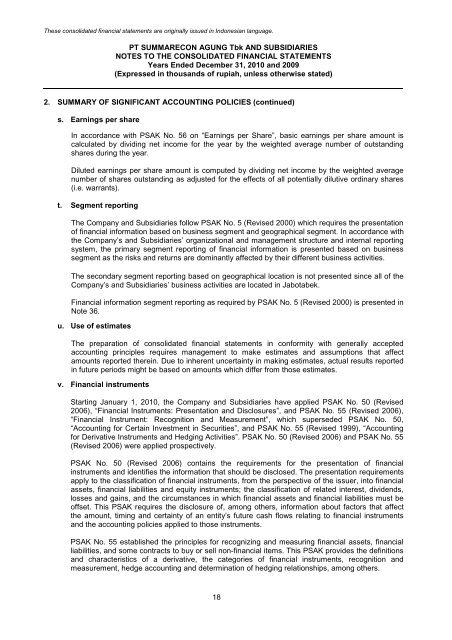PT Summarecon Agung Tbk | Laporan Tahunan 2010 Annual Report
PT Summarecon Agung Tbk | Laporan Tahunan 2010 Annual Report
PT Summarecon Agung Tbk | Laporan Tahunan 2010 Annual Report
Create successful ePaper yourself
Turn your PDF publications into a flip-book with our unique Google optimized e-Paper software.
These consolidated financial statements are originally issued in Indonesian language.<br />
<strong>PT</strong> SUMMARECON AGUNG <strong>Tbk</strong> AND SUBSIDIARIES<br />
NOTES TO THE CONSOLIDATED FINANCIAL STATEMENTS<br />
Years Ended December 31, <strong>2010</strong> and 2009<br />
(Expressed in thousands of rupiah, unless otherwise stated)<br />
2. SUMMARY OF SIGNIFICANT ACCOUNTING POLICIES (continued)<br />
s. Earnings per share<br />
In accordance with PSAK No. 56 on “Earnings per Share”, basic earnings per share amount is<br />
calculated by dividing net income for the year by the weighted average number of outstanding<br />
shares during the year.<br />
Diluted earnings per share amount is computed by dividing net income by the weighted average<br />
number of shares outstanding as adjusted for the effects of all potentially dilutive ordinary shares<br />
(i.e. warrants).<br />
t. Segment reporting<br />
The Company and Subsidiaries follow PSAK No. 5 (Revised 2000) which requires the presentation<br />
of financial information based on business segment and geographical segment. In accordance with<br />
the Company’s and Subsidiaries’ organizational and management structure and internal reporting<br />
system, the primary segment reporting of financial information is presented based on business<br />
segment as the risks and returns are dominantly affected by their different business activities.<br />
The secondary segment reporting based on geographical location is not presented since all of the<br />
Company’s and Subsidiaries’ business activities are located in Jabotabek.<br />
Financial information segment reporting as required by PSAK No. 5 (Revised 2000) is presented in<br />
Note 36.<br />
u. Use of estimates<br />
The preparation of consolidated financial statements in conformity with generally accepted<br />
accounting principles requires management to make estimates and assumptions that affect<br />
amounts reported therein. Due to inherent uncertainty in making estimates, actual results reported<br />
in future periods might be based on amounts which differ from those estimates.<br />
v. Financial instruments<br />
Starting January 1, <strong>2010</strong>, the Company and Subsidiaries have applied PSAK No. 50 (Revised<br />
2006), “Financial Instruments: Presentation and Disclosures”, and PSAK No. 55 (Revised 2006),<br />
“Financial Instrument: Recognition and Measurement”, which superseded PSAK No. 50,<br />
“Accounting for Certain Investment in Securities”, and PSAK No. 55 (Revised 1999), “Accounting<br />
for Derivative Instruments and Hedging Activities”. PSAK No. 50 (Revised 2006) and PSAK No. 55<br />
(Revised 2006) were applied prospectively.<br />
PSAK No. 50 (Revised 2006) contains the requirements for the presentation of financial<br />
instruments and identifies the information that should be disclosed. The presentation requirements<br />
apply to the classification of financial instruments, from the perspective of the issuer, into financial<br />
assets, financial liabilities and equity instruments; the classification of related interest, dividends,<br />
losses and gains, and the circumstances in which financial assets and financial liabilities must be<br />
offset. This PSAK requires the disclosure of, among others, information about factors that affect<br />
the amount, timing and certainty of an entity’s future cash flows relating to financial instruments<br />
and the accounting policies applied to those instruments.<br />
PSAK No. 55 established the principles for recognizing and measuring financial assets, financial<br />
liabilities, and some contracts to buy or sell non-financial items. This PSAK provides the definitions<br />
and characteristics of a derivative, the categories of financial instruments, recognition and<br />
measurement, hedge accounting and determination of hedging relationships, among others.<br />
18


